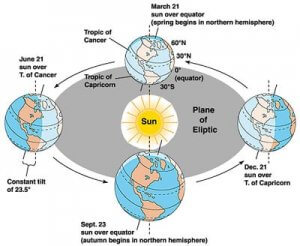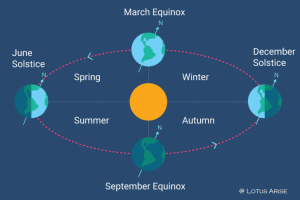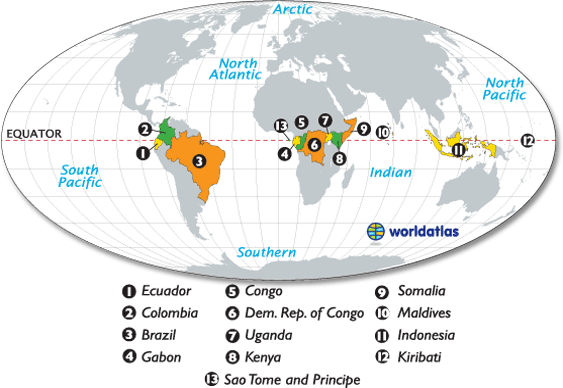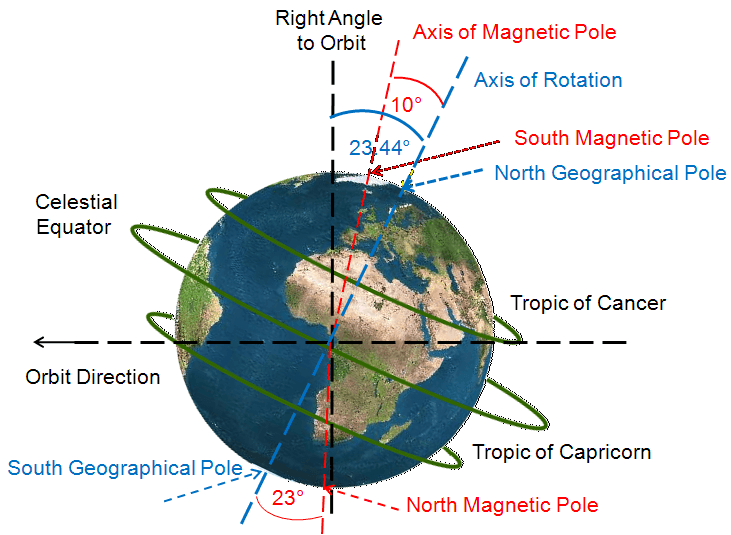Motions of the Earth: Earth has primarily two types of motions- Rotation and Revolution.
Rotation:
- Movement of the earth on its axis.
- Earth rotates along its axis from west to east.
- It takes approximately 24 hrs to complete on rotation.
- Days and nights occur due to rotation of the earth.
- The circle that divides the day from night on the globe is called the circle of illumination.
- Earth rotates on a tilted axis. Earth’s rotational axis makes an angle of 23.5° with the normal i.e. it makes an angle of 66.5° with the orbital plane. Orbital plane is the plane of earth’s orbit around the Sun.
Revolution:
- Movement of the earth around the sun in a fixed path or orbit.
- It takes 365¼ days (one year) to revolve around the sun
- Six hours saved every year are added to make one day (24 hours) over a span of four years. This surplus day is added to the month of February. Thus, every fourth year, February is of 29 days instead of 28 days. Such a year with 366 days is called a leap year.
Orbital plane: Axis of the earth which is an imaginary line makes an angle of 66½° with its orbital plane. The plane formed by the orbit is known as the orbital plane.

21st June/ Summer Solstice & 22nd December/ Winter Solstice
| Summer Solstice | Winter Solstice |
| Summer solstice occurs when North Pole is tilted closest to the Sun | Winter solstice occurs when North Pole is tilted farthest from the sun |
| It occurs on 21st June | It occurs on 22nd December |
| The summer solstice brings the longest day in the Northern Hemisphere, as it is tilted towards the sun. | Winter solstice brings the longest night in the Northern Hemisphere as it is tilted away from the sun |
| Southern Hemisphere has the shortest night | Southern Hemisphere has the longest days |
| Sun rays directly fall over Tropic of Cancer | Sun rays directly fall over Tropic of Capricorn |
| The places beyond the Arctic circle experience continuous daylight for about six months | The places beyond the Antarctic circle experience continuous daylight for about six months |
| As a large portion of Northern Hemisphere receives sunlight and heat during summer solstice, it is summers in Northern Hemisphere; whereas winters in Southern Hemisphere | As a large portion of Southern Hemisphere receives sunlight and heat during winter solstice, it is summer in Southern Hemisphere, whereas winter in Northern Hemisphere |
| Although the summer solstice is the longest day of the year for the Northern Hemisphere, the dates of the earliest sunrise and latest sunset vary by a few days.This is because the Earth orbits the Sun in an ellipse, and its orbital speed varies slightly during the year | Although the winter solstice itself lasts only a moment, the term sometimes refers to the day on which it occurs. |
| Although the Sun appears at its highest altitude from the viewpoint of an observer in outer space or a terrestrial observer outside tropical latitudes, the highest altitude occurs on a different day for certain locations in the tropics. | Traditionally, in many temperate regions, the winter solstice is seen as the middle of winter, but today in some countries and calendars, it is seen as the beginning of winter. |

Equinox
- The word equinox is derived from two Latin words – aequus (equal) and nox (night). Equinox refers to a day with an equal duration of day and night.
- There are only two times of the year when the Earth’s axis is tilted neither toward nor away from the sun, resulting in a nearly equal amount of daylight and darkness at all latitudes. These events are referred to as Equinoxes.
- The equinoxes happen in March (about March 21) and September (about September 23). These are the days when the Sun is exactly above the Equator, which makes day and night of equal length.
- It can be noted that the most places on Earth receive more than 12 hours of daylight on equinoxes. This is because of the atmospheric refraction of sunlight and how the length of the day is defined.
- The equinoxes are prime time for Northern Lights – geomagnetic activities are twice more likely to take place in the spring and fall time, than in the summer or winter.

Prime meridian
- The line that passes through the Greenwich, British Royal Observatory is regarded as Prime meridian.
- It is the base Longitude which is 0 degrees from where 180 degrees east and west directions are considered.
- Hence, Prime of Meridian is the base of world time.
- The Prime Meridian divides the Earth into two halves, Eastern and Western hemisphere.
Antarctic Circle
- The Antarctic Circle is one of the five major circles or parallels of latitude that mark maps of the Earth.
- The region south of this circle is known as the Antarctic, and the zone immediately to the north is called the Southern Temperate Zone.
- South of the Antarctic Circle, the Sun is above the horizon for 24 continuous hours at least once per year (and therefore visible at midnight) and the centre of the Sun (ignoring refraction) is below the horizon for 24 continuous hours at least once per year (and therefore not visible at noon); this is also true within the equivalent polar circle in the Northern Hemisphere, the Arctic Circle.
- The position of the Antarctic Circle is not fixed and currently runs 66°33′49.0″ south of the Equator.
EQUATOR
- The equator is located at zero degrees latitude.
- The Equator is a circle of latitude, about 40,075 km (24,901 mi) in circumference, that divides Earth into the Northern and Southern hemispheres.
- It is an imaginary line located at 0 degrees latitude, halfway between the North and South poles.
- The equator runs through Indonesia, Ecuador, northern Brazil, the Democratic Republic of the Congo, and Kenya, among other countries.
- On the equator, the sun is directly overhead at noon on the two equinoxes – near March and September 21.
- On the equator, the length of day and night is equal every day of the year-day is always 12 hours long and night is always 12 hours long.

TROPIC OF CANCER AND TROPIC OF CAPRICORN
- The Tropic of Capricorn can be found at latitude 23.5 degrees south.
- The Tropic of Cancer is at 23.5 degrees north.
- The equator is the circle where the sun can be found directly overhead at noon. when the Sun is directly over the Tropic of Capricorn at noon, it will not be visible from the Arctic Circle.
- The Tropics of Capricorn and Cancer were delineated because they are both places within the hemisphere where it’s possible for the sun to be directly overhead. When the Tropic of Cancer was first named about 2,000 years ago , the sun was pointed in the direction of the constellation of Cancer during the June solstice.
- The Tropic of Cancer is located at 23.5° North of the equator and runs through Mexico, the Bahamas, Egypt, Saudi Arabia, India, and southern China.
- The Tropic of Capricorn lies at 23.5° South of the equator and runs through Australia, Chile, southern Brazil (Brazil is the only country that passes through both the equator and a tropic), and northern South Africa.
Daylight saving in some temperate regions
- Daylight saving time (DST) or summer time is the practice of advancing clocks during summer months by one hour.
- In DST, evening time is increased by sacrificing the morning hours.
- Normal days = Start office at 10 AM and close at 5 PM
- In DST = Advance clock by one hour (can be more) = Start office at 9 AM and Close at 4 PM]
- Typically, users in regions with summertime (Some countries in extreme north and south) adjust clocks forward one hour close to the start of spring and adjust them backward in the autumn to standard time.
- Advantage: Putting clocks forward benefits retailing, sports, and other activities that exploit sunlight after working hours. Reduces evening use of incandescent lighting, which was formerly a primary use of electricity.
- Problems: DST clock shifts sometimes complicate timekeeping and can disrupt travel, billing, record keeping, medical devices, heavy equipment, and sleep patterns.

References: NCERT, G C Leong, Wikipedia

Awesome
wow I love it
I love it
Southern Hemisphere has the *shortest night…….longest night in summer solstice
right
Dear sir Tropic of cancer passes through 16 countries but in above notes you only mentioned some of them without using abbreviation (and other countries)